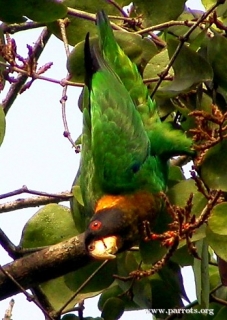Caica Parrot |
|
|
Also known as: Hooded Parrot
Photos
View in GalleryDid You Know?
The head of the juvenile Caica Parrot lacks the stunning black mask of the adult.Academic Research
Related publications: Pyrilia caicaSpecies Profile
Genus: Pyrilia | Species: caica
Size:
23cm (9 in)
Weight:
121-141g (4.2-5 oz)
Subspecies including nominate:
one
Colour Adult:
Both adults green in general; black/brown head; yellow/brown wide collar around nape and hindneck, with dark brown scalloping; olive/brown throat and upper breast; green bend of wing, carpal edge and underwing coverts. Bill horn in colour. Eye ring bare and pale grey. Eye orange.
Colour Juvenile:
Green occiput and crown; olive/green cheeks; yellow collar around hindneck, scalloping absent; green throat and upper breast with olive/yellow wash.
Call:
This bird is not very vocal; any calls made in flight are nasal or hornlike. When perched a nasal, honking sound.
Listen NowVideo Links:
Video 1 | Video 2More Information:
Content Sources:
CITES
BirdLife International
Cornell Lab of Ornithology/Birds of the World
Parrots: A Guide to Parrots of the World, Juniper and Parr, 1998
ML Media Collection Catalogue 127394, Caica Parrot Pionopsitta caica, Marantz, Curtis, Amazona, Brazil, Sep. 17 2000, Cornell Lab of Ornithology. Site
Parrots of the World, Forshaw, 2006. 2010 edition
Lexicon of Parrots, Thomas Arndt.
Photos
View in GalleryDid You Know?
The head of the juvenile Caica Parrot lacks the stunning black mask of the adult.Academic Research
Related publications: Pyrilia caicaSpecies Care
Captive Status:
Virtually unknown in captivity.
Longevity:
Not recorded.
Housing:
Inside enclosure 2 x 2 x 3m (6.5 x 6.5 x 9.8 ft).
Diet:
Fruits such as: apple, pear, banana, oranges, pomegranate, cactus fruits, mango, papaya; vegetables such as: carrot, celery, green beans, peas in the pod; lory nectar or porridge; small seed mix such as: millet, canary, safflower, oats, and a little hemp and sunflower; sprouted seed in spring and summer; vitamin and mineral supplements particularly C; complete kibble if taken.
Enrichment:
Provide unsprayed, bird-safe flowering and budding branches. Also wooden block toys, vegetable tanned leather toys and heat sterlized pine cones.
Nest Box Size:
Vertical box 10" x 10" x 24" (25.4cm x 25.4cm x 61cm)
Clutch Size:
Not recorded.
Incubation Time:
Not recorded.
Fledging Age:
Not recorded.
Hatch Weight:
Not recorded.
Peak Weight:
Not recorded.
Weaning Weight:
Not recorded.
Photos
View in GalleryDid You Know?
The head of the juvenile Caica Parrot lacks the stunning black mask of the adult.Academic Research
Related publications: Pyrilia caicaSpecies Wild Status
World Population:
Unknown, decreasing.
IUCN Red List Status:
Least Concern
CITES Listing:
Appendix II
Threat Summary:
Not globally threatened. Uncommon and local in E Venezuela, locally frequent in Guyana, scarce throughout Surinam, apparently common in interior French Guiana, and uncommon and local in N Brazil. Recently it was determined that deforestation in the Amazon Basin is not progressing as rapidly as once thought. May be vulnerable to hunting and persecution.
Range:
E Amazonia in Guianas, N Brazil, and E Venezuela.
Habitat:
Found up to 1100m (3608 ft) in lowland terra firme rainforest, sometimes at forest edge.
Wild Diet:
Feeds on seeds of Dracoides sagotianu, Protium, and Brosium. Once observed feeding on small red fruits.
Ecology and Behaviour:
Social. Mainly seen in small groups outside of breeding season. Birds forage in tree tops. Mainly keeps to upper canopy but may be seen on single bare branches projecting up and above canopy.
Clutch and Egg Size:
Not recorded.
Breeding Season:
November-January. Nest is in tree hollow.
Photos
View in GalleryDid You Know?
The head of the juvenile Caica Parrot lacks the stunning black mask of the adult.Academic Research
Related publications: Pyrilia caicaMembers Only Resources
Please log-in now to find more research, resources and tools.
Not a Member?
Find more great information:
Gain exclusive access to 600+ pages of additional research, seminars and podcasts, specialists to ask your toughest questions, and dozens of other fun resources - when you become a WPT member.
Join Today >>

































